AWS RDS : PostgreSQL 1
PostgreSQL is a general purpose and object-relational database management system, the most advanced open source database system (see http://www.postgresql.org/).
Compared to other RDBMSs, PostgreSQL differs itself with its support for highly required and integral object-oriented and/or relational database functionality, such as the complete support for reliable transactions, i.e. Atomicity, Consistency, Isolation, Durability (ACID).
Due to the powerful underlying technology, Postgres is extremely capable of handling many tasks very efficiently. Support for concurrency is achieved without read locks thanks to the implementation of Multiversion Concurrency Control (MVCC), which also ensures the ACID compliance.
PostgreSQL is highly programmable, and therefore extendible, with custom procedures that are called "stored procedures". These functions can be created to simplify the execution of repeated, complex and often required database operations.
In this tutorial, we'll see how we can create a Postgres DB vis RDS.
RDS provides options for DBs we can choose from:
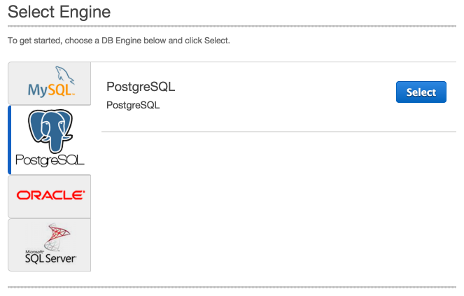
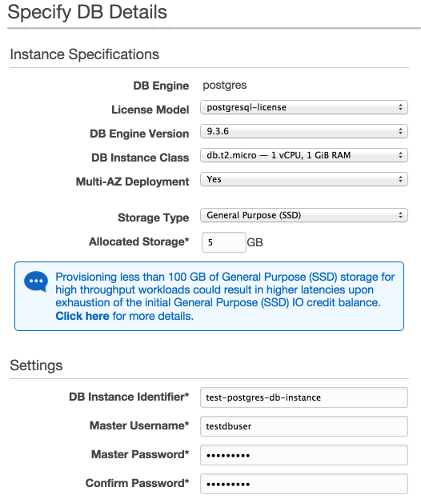
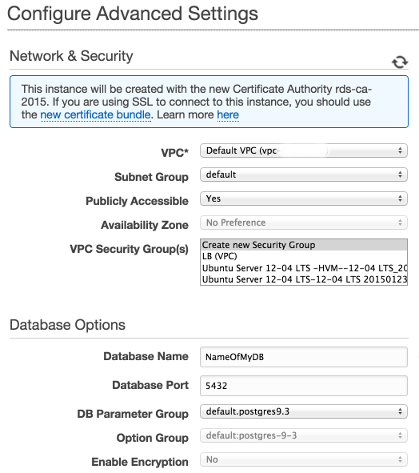
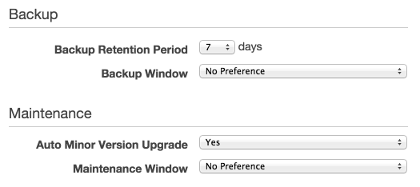
We need to modify the Security Group allowing None from All:
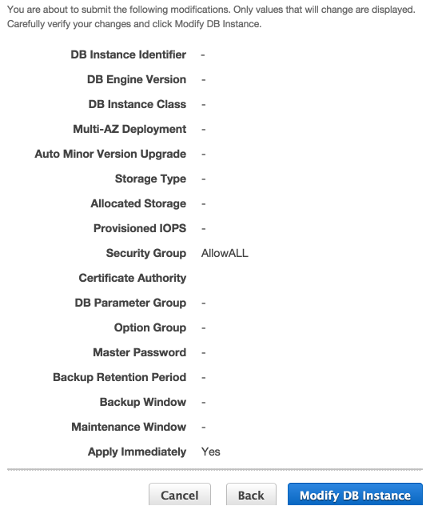
$ nc -vz test-postgres-db-instance.ca1jql6qyqdz.us-west-1.rds.amazonaws.com 5432
found 0 associations
found 1 connections:
1: flags=82<CONNECTED,PREFERRED>
outif utun0
src 172.27.235.208 port 60415
dst 172.31.5.252 port 5432
rank info not available
TCP aux info available
Connection to test-postgres-db-instance.ca1jql6qyqdz.us-west-1.rds.amazonaws.com port 5432 [tcp/postgresql] succeeded!
If we only want to connect to a PostgreSQL server, we don't have to install the whole PostgreSQL package, but install the PostgreSQL client instead:
$ sudo apt-get install postgresql-client $ psql --version psql (PostgreSQL) 9.3.6 $ psql --host=test-postgres-db-instance.ca1jql6qyqdz.us-west-1.rds.amazonaws.com --port=5432 --username=testdbuser --password --dbname=NameOfMyDB Password for user testdbuser: psql (9.3.6) SSL connection (cipher: DHE-RSA-AES256-SHA, bits: 256) Type "help" for help. NameOfMyDB=>
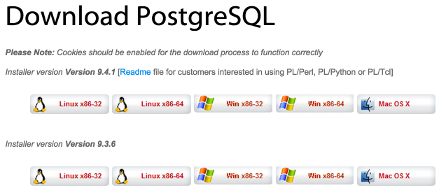
pgAdmin III is a handy GUI for PostgreSQL, it is essential to beginners. To install it, type at the command line:
$ sudo apt-get install pgadmin3
To get an idea of what PostgreSQL can do, we may start by firing up a graphical client. To launch the pgAdmin application on client computer, in a terminal type :
$ pgadmin3
Then, we will be presented with the pgAdmin III interface. Click on the "Add a connection to a server" button (top left):

In the New Server Registration dialog box, enter the following info:
- DB name : NameOfMyDB
- Host (DB instance endpoint) : test-postgres-db-instance.ca1jql6qyqdz.us-west-1.rds.amazonaws.com
- Username : testdbuser
- Password :

Click OK.
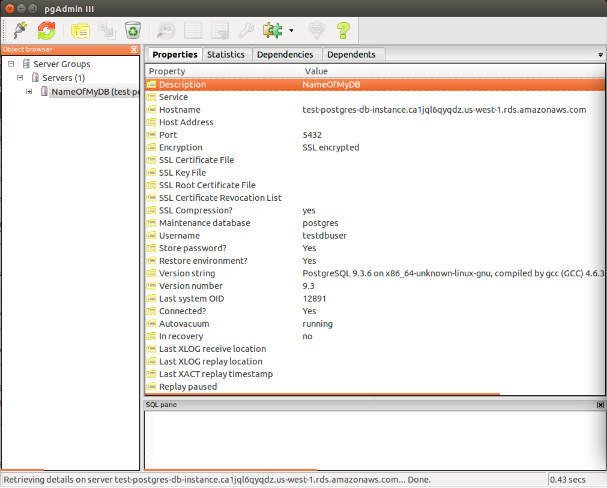
In the Object browser, expand the Server Groups. Select the Server (the DB instance) we created, and then select the database name:
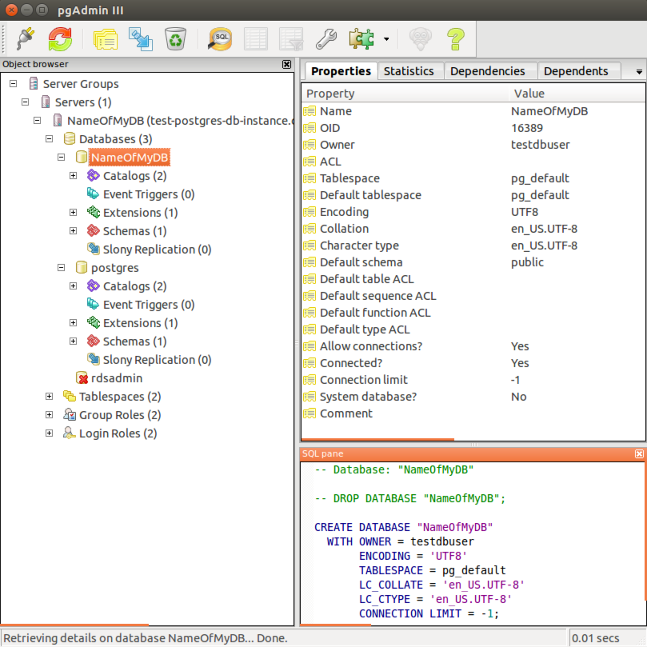
(Note on "rdsadmin") - This is Amazon's own user that is used by Amazon to perform updates, run backups and do other maintenance tasks.
AWS RDS : PostgreSQL 2 - Creating/Deleting a Table
AWS (Amazon Web Services)
- AWS : EKS (Elastic Container Service for Kubernetes)
- AWS : Creating a snapshot (cloning an image)
- AWS : Attaching Amazon EBS volume to an instance
- AWS : Adding swap space to an attached volume via mkswap and swapon
- AWS : Creating an EC2 instance and attaching Amazon EBS volume to the instance using Python boto module with User data
- AWS : Creating an instance to a new region by copying an AMI
- AWS : S3 (Simple Storage Service) 1
- AWS : S3 (Simple Storage Service) 2 - Creating and Deleting a Bucket
- AWS : S3 (Simple Storage Service) 3 - Bucket Versioning
- AWS : S3 (Simple Storage Service) 4 - Uploading a large file
- AWS : S3 (Simple Storage Service) 5 - Uploading folders/files recursively
- AWS : S3 (Simple Storage Service) 6 - Bucket Policy for File/Folder View/Download
- AWS : S3 (Simple Storage Service) 7 - How to Copy or Move Objects from one region to another
- AWS : S3 (Simple Storage Service) 8 - Archiving S3 Data to Glacier
- AWS : Creating a CloudFront distribution with an Amazon S3 origin
- AWS : Creating VPC with CloudFormation
- AWS : WAF (Web Application Firewall) with preconfigured CloudFormation template and Web ACL for CloudFront distribution
- AWS : CloudWatch & Logs with Lambda Function / S3
- AWS : Lambda Serverless Computing with EC2, CloudWatch Alarm, SNS
- AWS : Lambda and SNS - cross account
- AWS : CLI (Command Line Interface)
- AWS : CLI (ECS with ALB & autoscaling)
- AWS : ECS with cloudformation and json task definition
- AWS Application Load Balancer (ALB) and ECS with Flask app
- AWS : Load Balancing with HAProxy (High Availability Proxy)
- AWS : VirtualBox on EC2
- AWS : NTP setup on EC2
- AWS: jq with AWS
- AWS & OpenSSL : Creating / Installing a Server SSL Certificate
- AWS : OpenVPN Access Server 2 Install
- AWS : VPC (Virtual Private Cloud) 1 - netmask, subnets, default gateway, and CIDR
- AWS : VPC (Virtual Private Cloud) 2 - VPC Wizard
- AWS : VPC (Virtual Private Cloud) 3 - VPC Wizard with NAT
- DevOps / Sys Admin Q & A (VI) - AWS VPC setup (public/private subnets with NAT)
- AWS - OpenVPN Protocols : PPTP, L2TP/IPsec, and OpenVPN
- AWS : Autoscaling group (ASG)
- AWS : Setting up Autoscaling Alarms and Notifications via CLI and Cloudformation
- AWS : Adding a SSH User Account on Linux Instance
- AWS : Windows Servers - Remote Desktop Connections using RDP
- AWS : Scheduled stopping and starting an instance - python & cron
- AWS : Detecting stopped instance and sending an alert email using Mandrill smtp
- AWS : Elastic Beanstalk with NodeJS
- AWS : Elastic Beanstalk Inplace/Rolling Blue/Green Deploy
- AWS : Identity and Access Management (IAM) Roles for Amazon EC2
- AWS : Identity and Access Management (IAM) Policies, sts AssumeRole, and delegate access across AWS accounts
- AWS : Identity and Access Management (IAM) sts assume role via aws cli2
- AWS : Creating IAM Roles and associating them with EC2 Instances in CloudFormation
- AWS Identity and Access Management (IAM) Roles, SSO(Single Sign On), SAML(Security Assertion Markup Language), IdP(identity provider), STS(Security Token Service), and ADFS(Active Directory Federation Services)
- AWS : Amazon Route 53
- AWS : Amazon Route 53 - DNS (Domain Name Server) setup
- AWS : Amazon Route 53 - subdomain setup and virtual host on Nginx
- AWS Amazon Route 53 : Private Hosted Zone
- AWS : SNS (Simple Notification Service) example with ELB and CloudWatch
- AWS : Lambda with AWS CloudTrail
- AWS : SQS (Simple Queue Service) with NodeJS and AWS SDK
- AWS : Redshift data warehouse
- AWS : CloudFormation
- AWS : CloudFormation Bootstrap UserData/Metadata
- AWS : CloudFormation - Creating an ASG with rolling update
- AWS : Cloudformation Cross-stack reference
- AWS : OpsWorks
- AWS : Network Load Balancer (NLB) with Autoscaling group (ASG)
- AWS CodeDeploy : Deploy an Application from GitHub
- AWS EC2 Container Service (ECS)
- AWS EC2 Container Service (ECS) II
- AWS Hello World Lambda Function
- AWS Lambda Function Q & A
- AWS Node.js Lambda Function & API Gateway
- AWS API Gateway endpoint invoking Lambda function
- AWS API Gateway invoking Lambda function with Terraform
- AWS API Gateway invoking Lambda function with Terraform - Lambda Container
- Amazon Kinesis Streams
- AWS: Kinesis Data Firehose with Lambda and ElasticSearch
- Amazon DynamoDB
- Amazon DynamoDB with Lambda and CloudWatch
- Loading DynamoDB stream to AWS Elasticsearch service with Lambda
- Amazon ML (Machine Learning)
- Simple Systems Manager (SSM)
- AWS : RDS Connecting to a DB Instance Running the SQL Server Database Engine
- AWS : RDS Importing and Exporting SQL Server Data
- AWS : RDS PostgreSQL & pgAdmin III
- AWS : RDS PostgreSQL 2 - Creating/Deleting a Table
- AWS : MySQL Replication : Master-slave
- AWS : MySQL backup & restore
- AWS RDS : Cross-Region Read Replicas for MySQL and Snapshots for PostgreSQL
- AWS : Restoring Postgres on EC2 instance from S3 backup
- AWS : Q & A
- AWS : Security
- AWS : Security groups vs. network ACLs
- AWS : Scaling-Up
- AWS : Networking
- AWS : Single Sign-on (SSO) with Okta
- AWS : JIT (Just-in-Time) with Okta
Ph.D. / Golden Gate Ave, San Francisco / Seoul National Univ / Carnegie Mellon / UC Berkeley / DevOps / Deep Learning / Visualization